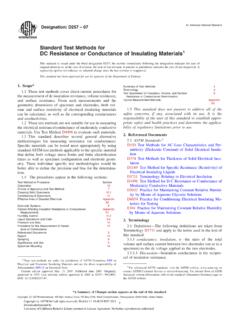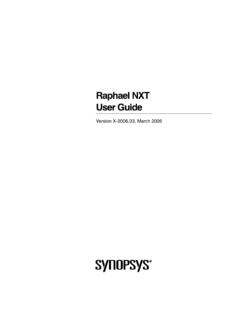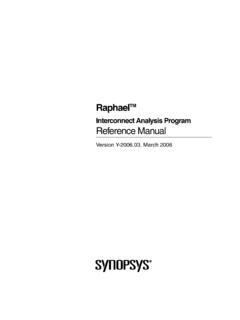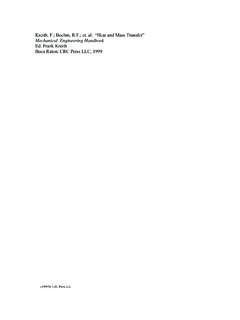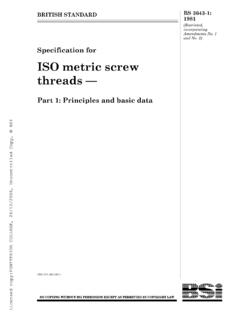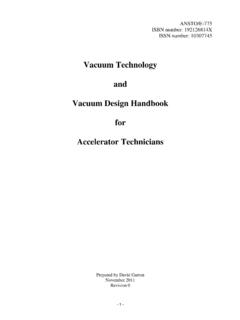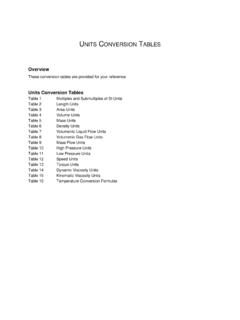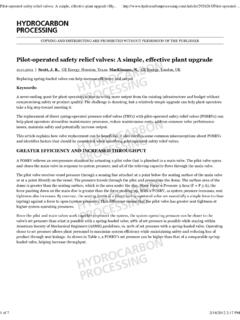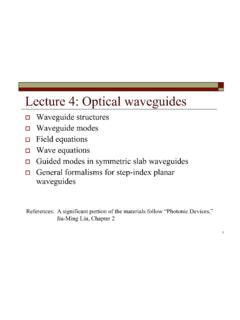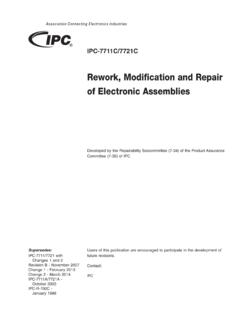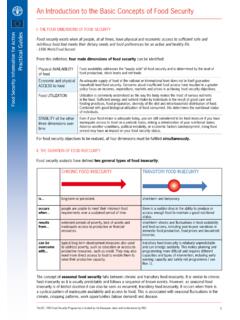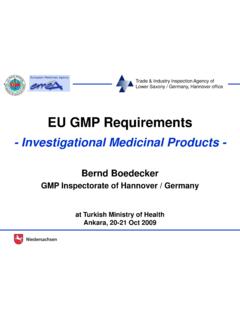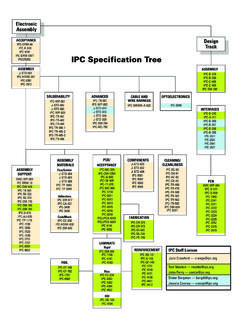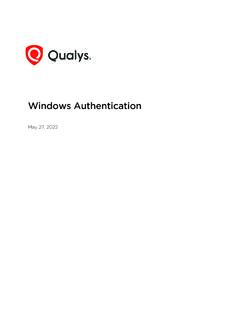Transcription of ASSOCIATION CONNECTING ELECTRONICS INDUSTRIES IPC …
1 IPC-2221 AGeneric Standard onPrinted Board DesignASSOCIATION CONNECTINGELECTRONICS INDUSTRIES 2215 Sanders Road, Northbrook, IL 60062-6135 Tel. Fax 2003A standard developed by IPCS upersedes IPC-2221 February 1998 The Principles ofStandardizationIn May 1995 the IPC s Technical Activities Executive Committee adopted Principles ofStandardization as a guiding principle of IPC s standardization Should: Show relationship to Design for Manufacturability(DFM) and Design for the Environment (DFE) Minimize time to market Contain simple (simplified) language Just include spec information Focus on end product performance Include a feedback system on use andproblems for future improvementStandards Should Not: Inhibit innovation Increase time-to-market Keep people out Increase cycle time Tell you how to make something Contain anything that cannotbe defended with dataNoticeIPC Standards and Publications are designed to serve the public interest through eliminating mis-understandings between manufacturers and purchasers, facilitating interchangeability and improve-ment of products, and assisting the purchaser in selecting and obtaining with minimum delay theproper product for his particular need.
2 Existence of such Standards and Publications shall not inany respect preclude any member or nonmember of IPC from manufacturing or selling productsnot conforming to such Standards and Publication, nor shall the existence of such Standards andPublications preclude their voluntary use by those other than IPC members, whether the standardis to be used either domestically or Standards and Publications are adopted by IPC without regard to whether their adop-tion may involve patents on articles, materials, or processes. By such action, IPC does not assumeany liability to any patent owner, nor do they assume any obligation whatever to parties adoptingthe Recommended Standard or Publication. Users are also wholly responsible for protecting them-selves against all claims of liabilities for patent PositionStatement onSpecificationRevision ChangeIt is the position of IPC s Technical Activities Executive Committee (TAEC) that the use andimplementation of IPC publications is voluntary and is part of a relationship entered into bycustomer and supplier.
3 When an IPC publication is updated and a new revision is published, itis the opinion of the TAEC that the use of the new revision as part of an existing relationshipis not automatic unless required by the contract. The TAEC recommends the use of the October 6. 1998 Why is therea charge forthis document?Your purchase of this document contributes to the ongoing development of new and updated indus-try standards and publications. Standards allow manufacturers, customers, and suppliers to under-stand one another better. Standards allow manufacturers greater efficiencies when they can setup their processes to meet industry standards, allowing them to offer their customers lower spends hundreds of thousands of dollars annually to support IPC s volunteers in the standardsand publications development process. There are many rounds of drafts sent out for review andthe committees spend hundreds of hours in review and development.
4 IPC s staff attends and par-ticipates in committee activities, typesets and circulates document drafts, and follows all necessaryprocedures to qualify for ANSI s membership dues have been kept low to allow as many companies as possible to , the standards and publications revenue is necessary to complement dues revenue. Theprice schedule offers a 50% discount to IPC members. If your company buys IPC standards andpublications, why not take advantage of this and the many other benefits of IPC membership aswell? For more information on membership in IPC, please visit or call 847 you for your continued support. Copyright 2003 . IPC, Northbrook, Illinois. All rights reserved under both international and Pan-American copyright copying,scanning or other reproduction of these materials without the prior written consent of the copyright holder is strictly prohibited and constitutesinfringement under the Copyright Law of the United Standard onPrinted Board DesignDeveloped by the IPC-2221 Task Group (D-31b) of the Rigid PrintedBoard Committee (D-30) of IPCU sers of this publication are encouraged to participate in thedevelopment of future :IPC2215 Sanders RoadNorthbrook, Illinois60062-6135 Tel 847 847 :IPC-2221 - February 1998 ASSOCIATION CONNECTINGELECTRONICS INDUSTRIES FOREWORDThis standard is intended to provide information on the generic requirements for organic printed board design.
5 All aspectsand details of the design requirements are addressed to the extent that they can be applied to the broad spectrum of thosedesigns that use organic materials or organic materials in combination with inorganic materials (metal, glass, ceramic, etc.)to provide the structure for mounting and interconnecting electronic, electromechanical, and mechanical components. It iscrucial that a decision pertaining to the choice of product types be made as early as possible. Once a component mountingand interconnecting technology has been selected the user should obtain the sectional document that provides the specificfocus on the chosen may be more effective to consider alternative printed board construction types for the product being designed. As anexample the application of a rigid-flex printed wiring board may be more cost or performance effective than using multipleprinted wiring boards, connectors and s documentation strategy is to provide distinct documents that focus on specific aspect of electronic packaging this regard document sets are used to provide the total information related to a particular electronic packaging topic.
6 Adocument set is identified by a four digit number that ends in zero (0).Included in the set is the generic information which is contained in the first document of the set and identified by the fourdigit set number. The generic standard is supplemented by one or many sectional documents each of which provide specificfocus on one aspect of the topic or the technology selected. The user needs, as a minimum, the generic design document,the sectional of the chosen technology, and the engineering description of the final technology changes specific focus standards will be updated, or new focus standards added to the document set. The IPCinvites input on the effectiveness of the documentation and encourages user response through completion of Suggestionsfor Improvement forms located at the end of each OF IPC DESIGN SPECIFICATIONS(2220 SERIES)IPC-2222 RIGIDIPC-2223 FLEXIPC-2224 PCMCIAIPC-2225 MCM-LIPC-2226 HDISIPC-2221 GENERIC DESIGNA cknowledgmentAny document involving a complex technology draws material from a vast number of sources.
7 While the principal membersof the IPC-2221 Task Group (D-31b) of the Rigid Printed Board Committee (D-30) are shown below, it is not possible toinclude all of those who assisted in the evolution of this Standard. To each of them, the members of the IPC extend Printed BoardCommitteeIPC-2221 Task GroupTechnical Liaison of theIPC Board of DirectorsChairC. Don DupriestLockheed Martin Missilesand Fire ControlChairLionel FullwoodWKK Distribution S. NaikEagle Circuits Task GroupLance A. Auer, Tyco Printed CircuitGroupStephen Bakke, , AlliantTechsystems Belisle, Hamilton SundstrandMark Bentlage, IBM CorporationRobert J. Black, Northrop GrummanCorporationGerald Leslie Bogert, Bechtel PlantMachinery, L. Bourque, , Shure A. Bowles, Sovereign J. Brock, NSWC - CraneMark BuechnerLewis Burnett, Honeywell Case, L-3 CommunicationsIgnatius Chong, CelesticaInternational R.
8 Coapman, Delphi DelcoElectronics SystemsChristopher Conklin, LockheedMartin CorporationDavid J. Corbett, Defense SupplyCenter ColumbusBrian Crowley, Hewlett-PackardCompanyWilliam C. Dieffenbacher, BAES ystems ControlsGerhard Diehl, Alcatel SEL AGC. Don Dupriest, Lockheed MartinMissiles and Fire ControlJohn Dusl, Lockheed MartinTheodore Edwards, Dynaco Engelmaier, EngelmaierAssociates, M. Ferrari, +, FerrariTechnical ServicesGeorge Franck, +, RaytheonE-SystemsMahendra S. Gandhi, NorthropGrummanHue T. Green, Lockheed MartinSpace and Strategic MissilesKen Greene, Siemens Energy &AutomationMichael R. Green, Lockheed MartinSpace and Strategic MissilesDr. Samy Hanna, AT&S AustriaTechnologie & SystemRichard P. Hartley, , HartleyEnterprisesWilliam Hazen, Raytheon CompanyPhillip E. Hinton, Hinton PWB EngineeringMichael Jouppi, Thermal Man, E. Kemp Rockwell CollinsFrank N.
9 Kimmey, +,PowerWave Technologies, Kumar, , SolectronInvotronicsClifford H. Lamson, +, PlexusTechnology GroupRoger H. Landolt, CooksonElectronicsMichael G. Luke, , RaytheonCompanyWesley R. Malewicz, SiemensMedical Systems Manning, RaytheonCompanySusan S. Mansilla, RobisanLaboratory R. Martinez, NorthropGrummanBrian C. McCrory, Delsen TestingLaboratoriesRandy McNutt, Northrop GrummanJohn H. Morton, , LockheedMartin CorporationBob Neves, Microtek LaboratoriesBenny Nilsson, Ericsson ABSteven M. Nolan, +, SiliconGraphics Computer SystemRandy R. Reed, Merix CorporationKelly M. Schriver, SchriverConsultantsJeff Seekatz, Raytheon CompanyKenneth C. Selk, Northrop GrummanRussell S. Shepherd, MicrotekLaboratoriesLowell Sherman, Defense SupplyCenter ColumbusAkikazu Shibata, , JPCA-JapanPrinted Circuit AssociationJeff Shubrooks, Raytheon CompanyMark Snow, BAE SystemsRoger Su, L-3 CommunicationsRonald E.
10 Thompson, NSWC - CraneMax E. Thorson, ,Hewlett-Packard CompanyDung Q. Tiet, Lockheed MartinSpace and Strategic MissilesDewey Whittaker, Honeywell L. Wolf, Conductor AnalysisTechnology, V. Yohe, , Yohe DesignServicesMay 2003 IPC-2221 AiiiTable of .. Hierarchy .. of Terms .. of Products .. Type .. Classes .. Level .. Level Changes .. 22 APPLICABLE .. Industry Standards .. of Automotive Engineers .. Society for Testing and Materials .. Labs .. 43 GENERAL Hierarchy .. of Precedence .. Layout .. Requirements .. Evaluation .. Diagram .. List .. Requirement Considerations .. Board Assembly Testability .. Scan Testing .. Test Concern for Printed BoardAssemblies .. Test Concerns for Printed BoardAssemblies .. Evaluation .. Layout Design .. Density Evaluation .. Requirements.
